TCRT5000L:Datasheet, Package, and Manufacturer
VISHAY - TCRT5000L - OPTICAL SENSOR, REFLECTIVE
The TCRT5000L is a reflective sensor that includes an infrared emitter and phototransistor in a leaded package. This passage is going to introduce TCRT5000L from the perspectives of TCRT5000L description, TCRT5000L datasheet, TCRT5000L features, and so on.

TCRT5000 Infrared Reflective Sensor - How it works and example circuit with code.
TCRT5000L Description
The TCRT5000L is a reflective sensor with an infrared emitter and phototransistor housed in a leaded package that blocks visible light. Two mounting clips are included in the package. The long lead version is designated as TCRT5000L.
TCRT5000L Feature
• Package type: leaded
• Detector type: phototransistor
• Dimensions (L x W x H in mm): 10.2 x 5.8 x 7
• Peak operating distance: 2.5 mm
• Operating range within > 20 % relative collector current: 0.2 mm to 15 mm
• Typical output current under test: IC = 1 mA
• Daylight blocking filter
• Emitter wavelength: 950 nm
• Lead (Pb)-free soldering released
• Compliant to RoHS directive 2002/95/EC and in accordance to WEEE 2002/96/EC
TCRT5000L Applications
Automotive
Advanced driver assistance systems (ADAS)/Body electronics & lightingy/Hbrid, electric & powertrain system/sInfotainment & cluster
Communications equipment
Broadband fixed-line access/Datacom module/Wired networking/Wireless infrastructure
Industrial
Aerospace & defense/Appliances/Building automation/Electronic point of sale (EPOS)/Factory automation & control/Grid infrastructure/Industrial transport (non-car & non-light truck)/Lighting/Medical/Motor drives/Power delivery/Pro audio, video & signage/Test & measurement
TCRT5000L CAD Models
Symbols
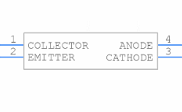
Footprint
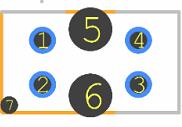
3D Models
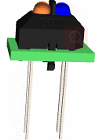
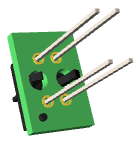
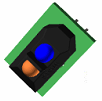
TCRT5000L Package
The TCRT5000L is a reflective sensor that includes an infrared emitter and phototransistor in a leaded package. The sensor package blocks visible light and is sensitive to the IR light emitted by the IR led emitter. The package includes two mounting clips and is the long lead version. Ideal for distance sensing of nearby objects, line detection, etc.
Features
Package-Type: Leaded
Detector Type: Phototransistor
Dimensions: 10.2 x 5.8 x 7mm
Peak Operating Distance: 2.5mm
Daylight Blocking Filter
Emitter Wavelength: 950nm
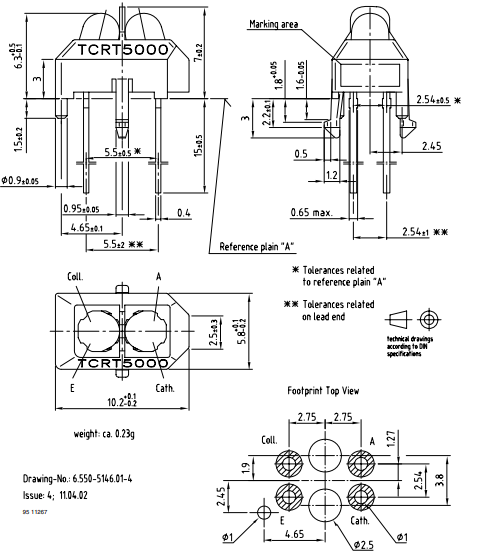
TCRT5000L Pin Configuration
| 1 | Collector | The collector of the phototransistor is connected to +5V |
| 2 | Emitter | The emitter of the phototransistor is grounded through a resistor |
| 3 | Anode | The Anode of the photodiode is connected to +5V |
| 4 | Cathode | The cathode of the photodiode is grounded through a resistor |
Where to use TCRT5000L?
The TCRT5000L is an infrared sensor. Its package contains both a photodiode and a phototransistor. An IR signal can be generated using the photo diode's two pins (Anode and Cathode). Similarly, the Phototransistor has two pins (Collector and Emitter) that can be used to read the reflected IR signal. This sensor can be used to detect the presence of an object or any other reflective surface in front of it, as well as calculate the distance of the object in front of it with some level of programming. However, the distance can only be calculated for short-range objects and is also affected by environmental factors. So, if you're looking for a sensor to measure the distance between two objects, consider the HC-SR04 Ultrasonic sensor.
Aside from that, this sensor is ideal for detecting the presence of an object in front of it. It can also distinguish between black and white colors, making it popular in line-following and maze-solving robots.
How to use TCRT5000L?
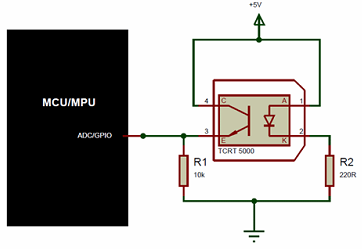
The TCRT500 sensor is simply a photodiode and a phototransistor combined. The photodiode is powered by a 220R current limiting resistor, and the transistor is grounded by a 10K resistor, as shown in the diagram below. Because the transistor biasing is controlled by the amount of IR light it receives, it lacks a base pin. In essence, the IR light from the photodiode strikes an object/surface and returns to the phototransistor to bias it.
This sensor can be used as either an analog or a digital sensor. If we only need to detect the presence of an object, the sensor will be used as a digital sensor; if we also need to measure the distance of the object, the sensor will be used as an analog sensor. The circuit diagram shown above will remain the same for either method.
One significant disadvantage of such IR sensors is that they are easily affected by environmental conditions. The phototransistor, for example, will not only react to IR light from the photodiode, but also to IR light from the sun, house lighting, and other commonly available sources. This issue is typically addressed in the program by performing noise cancellation. That is, by controlling the photodiode itself via a GPIO pin on the MCU/MPU, we can turn it off and see how much noise the phototransistor is reading, then turn it back on and measure the change in values by canceling out the noise that was present while the diode was turned off.
TCRT5000L Manufacturer
Vishay is a global manufacturer of discrete semiconductors and passive components. It manufactures diodes, rectifiers, MOSFETs, optoelectronics, selected integrated circuits, resistors, capacitors, inductors, sensors, and transducers. These components are found in almost every type of electronic device and equipment, including those used in the industrial, computing, automotive, consumer, telecommunications, military, aerospace, and medical markets.
Specifications
- TypeParameter
- Factory Lead Time32 Weeks
- Contact Plating
Contact plating (finish) provides corrosion protection for base metals and optimizes the mechanical and electrical properties of the contact interfaces.
Silver, Tin - Mount
In electronic components, the term "Mount" typically refers to the method or process of physically attaching or fixing a component onto a circuit board or other electronic device. This can involve soldering, adhesive bonding, or other techniques to secure the component in place. The mounting process is crucial for ensuring proper electrical connections and mechanical stability within the electronic system. Different components may have specific mounting requirements based on their size, shape, and function, and manufacturers provide guidelines for proper mounting procedures to ensure optimal performance and reliability of the electronic device.
Through Hole - Mounting Type
The "Mounting Type" in electronic components refers to the method used to attach or connect a component to a circuit board or other substrate, such as through-hole, surface-mount, or panel mount.
Through Hole - Package / Case
refers to the protective housing that encases an electronic component, providing mechanical support, electrical connections, and thermal management.
PCB Mount - Number of Pins4
- Collector-Emitter Breakdown Voltage70V
- Current-Collector (Ic) (Max)100mA
- Number of Elements1
- Operating Temperature
The operating temperature is the range of ambient temperature within which a power supply, or any other electrical equipment, operate in. This ranges from a minimum operating temperature, to a peak or maximum operating temperature, outside which, the power supply may fail.
-25°C~85°C - Packaging
Semiconductor package is a carrier / shell used to contain and cover one or more semiconductor components or integrated circuits. The material of the shell can be metal, plastic, glass or ceramic.
Tube - Published2009
- Part Status
Parts can have many statuses as they progress through the configuration, analysis, review, and approval stages.
Active - Moisture Sensitivity Level (MSL)
Moisture Sensitivity Level (MSL) is a standardized rating that indicates the susceptibility of electronic components, particularly semiconductors, to moisture-induced damage during storage and the soldering process, defining the allowable exposure time to ambient conditions before they require special handling or baking to prevent failures
1 (Unlimited) - Max Operating Temperature
The Maximum Operating Temperature is the maximum body temperature at which the thermistor is designed to operate for extended periods of time with acceptable stability of its electrical characteristics.
85°C - Min Operating Temperature
The "Min Operating Temperature" parameter in electronic components refers to the lowest temperature at which the component is designed to operate effectively and reliably. This parameter is crucial for ensuring the proper functioning and longevity of the component, as operating below this temperature may lead to performance issues or even damage. Manufacturers specify the minimum operating temperature to provide guidance to users on the environmental conditions in which the component can safely operate. It is important to adhere to this parameter to prevent malfunctions and ensure the overall reliability of the electronic system.
-25°C - Voltage - Rated DC
Voltage - Rated DC is a parameter that specifies the maximum direct current (DC) voltage that an electronic component can safely handle without being damaged. This rating is crucial for ensuring the proper functioning and longevity of the component in a circuit. Exceeding the rated DC voltage can lead to overheating, breakdown, or even permanent damage to the component. It is important to carefully consider this parameter when designing or selecting components for a circuit to prevent any potential issues related to voltage overload.
1.25V - Max Power Dissipation
The maximum power that the MOSFET can dissipate continuously under the specified thermal conditions.
200mW - Output Voltage
Output voltage is a crucial parameter in electronic components that refers to the voltage level produced by the component as a result of its operation. It represents the electrical potential difference between the output terminal of the component and a reference point, typically ground. The output voltage is a key factor in determining the performance and functionality of the component, as it dictates the level of voltage that will be delivered to the connected circuit or load. It is often specified in datasheets and technical specifications to ensure compatibility and proper functioning within a given system.
70V - Output Type
The "Output Type" parameter in electronic components refers to the type of signal or data that is produced by the component as an output. This parameter specifies the nature of the output signal, such as analog or digital, and can also include details about the voltage levels, current levels, frequency, and other characteristics of the output signal. Understanding the output type of a component is crucial for ensuring compatibility with other components in a circuit or system, as well as for determining how the output signal can be utilized or processed further. In summary, the output type parameter provides essential information about the nature of the signal that is generated by the electronic component as its output.
Phototransistor - Number of Channels1
- Power Dissipation
the process by which an electronic or electrical device produces heat (energy loss or waste) as an undesirable derivative of its primary action.
200mW - Forward Current
Current which flows upon application of forward voltage.
60mA - Forward Voltage
the amount of voltage needed to get current to flow across a diode.
1.25V - Collector Emitter Voltage (VCEO)
Collector-Emitter Voltage (VCEO) is a key parameter in electronic components, particularly in transistors. It refers to the maximum voltage that can be applied between the collector and emitter terminals of a transistor while the base terminal is open or not conducting. Exceeding this voltage limit can lead to breakdown and potential damage to the transistor. VCEO is crucial for ensuring the safe and reliable operation of the transistor within its specified limits. Designers must carefully consider VCEO when selecting transistors for a circuit to prevent overvoltage conditions that could compromise the performance and longevity of the component.
70V - Max Collector Current
Max Collector Current is a parameter used to specify the maximum amount of current that can safely flow through the collector terminal of a transistor or other electronic component without causing damage. It is typically expressed in units of amperes (A) and is an important consideration when designing circuits to ensure that the component operates within its safe operating limits. Exceeding the specified max collector current can lead to overheating, degradation of performance, or even permanent damage to the component. Designers must carefully consider this parameter when selecting components and designing circuits to ensure reliable and safe operation.
100mA - Sensing Distance
It is the sensing range for which the sensor can stably detect the standard sensing object even if there is an ambient temperature drift and/or supply voltage fluctuation. (Normally, it is 70 to 80 % of the maximum operation distance.)
0.591 (15mm) - Voltage - Collector Emitter Breakdown (Max)
Voltage - Collector Emitter Breakdown (Max) is a parameter that specifies the maximum voltage that can be applied between the collector and emitter terminals of a transistor or other semiconductor device before it breaks down and allows excessive current to flow. This parameter is crucial for ensuring the safe and reliable operation of the component within its specified limits. Exceeding the maximum breakdown voltage can lead to permanent damage or failure of the device. Designers and engineers must carefully consider this parameter when selecting components for their circuits to prevent potential issues and ensure proper functionality.
70V - Reverse Breakdown Voltage
Reverse Breakdown Voltage is the maximum reverse voltage a semiconductor device can withstand before it starts to conduct heavily in the reverse direction. It is a critical parameter in diodes and other components, indicating the threshold at which the material's insulating properties fail. Beyond this voltage, the device may enter a breakdown region, leading to potential damage if not properly managed. This parameter is essential for ensuring safe operation and reliability in electronic circuits.
5V - Sensing Method
The sensing method in electronic components refers to the technique or mechanism used to detect and measure physical phenomena such as temperature, pressure, light, or motion. This includes a variety of technologies such as resistive, capacitive, inductive, and optical sensing methods. The choice of sensing method affects the accuracy, response time, and application suitability of the electronic component. It plays a crucial role in determining how effectively a device can interact with and interpret its environment.
Reflective - Current - DC Forward (If) (Max)
The parameter "Current - DC Forward (If) (Max)" in electronic components refers to the maximum forward current that can safely pass through the component without causing damage. This parameter is typically specified in datasheets for diodes and LEDs, indicating the maximum current that can flow through the component in the forward direction. Exceeding this maximum current rating can lead to overheating and potentially permanent damage to the component. It is important to ensure that the current flowing through the component does not exceed this specified maximum to maintain proper functionality and reliability.
60mA - Input Current
Input current is a parameter that refers to the amount of electrical current flowing into a specific electronic component or device. It is typically measured in amperes (A) and represents the current required for the component to operate properly. Understanding the input current is important for designing circuits and power supplies, as it helps determine the capacity and compatibility of the components being used. Monitoring the input current also helps ensure that the component is not being overloaded or underpowered, which can affect its performance and longevity.
60mA - Reverse Voltage (DC)
Reverse Voltage (DC) refers to the maximum voltage that an electronic component, typically a semiconductor device like a diode, can withstand in the reverse direction without undergoing breakdown or failure. It indicates the threshold at which the device will start to conduct in reverse, potentially damaging the component. This parameter is crucial for ensuring the reliability and safety of circuits that may experience reverse polarity or unexpected voltage conditions. Exceeding the specified reverse voltage can lead to permanent damage or catastrophic failure of the component.
5V - Height7mm
- Length10.2mm
- Width5.8mm
- REACH SVHC
The parameter "REACH SVHC" in electronic components refers to the compliance with the Registration, Evaluation, Authorization, and Restriction of Chemicals (REACH) regulation regarding Substances of Very High Concern (SVHC). SVHCs are substances that may have serious effects on human health or the environment, and their use is regulated under REACH to ensure their safe handling and minimize their impact.Manufacturers of electronic components need to declare if their products contain any SVHCs above a certain threshold concentration and provide information on the safe use of these substances. This information allows customers to make informed decisions about the potential risks associated with using the components and take appropriate measures to mitigate any hazards.Ensuring compliance with REACH SVHC requirements is essential for electronics manufacturers to meet regulatory standards, protect human health and the environment, and maintain transparency in their supply chain. It also demonstrates a commitment to sustainability and responsible manufacturing practices in the electronics industry.
No SVHC - Radiation Hardening
Radiation hardening is the process of making electronic components and circuits resistant to damage or malfunction caused by high levels of ionizing radiation, especially for environments in outer space (especially beyond the low Earth orbit), around nuclear reactors and particle accelerators, or during nuclear accidents or nuclear warfare.
No - RoHS Status
RoHS means “Restriction of Certain Hazardous Substances” in the “Hazardous Substances Directive” in electrical and electronic equipment.
ROHS3 Compliant - Lead Free
Lead Free is a term used to describe electronic components that do not contain lead as part of their composition. Lead is a toxic material that can have harmful effects on human health and the environment, so the electronics industry has been moving towards lead-free components to reduce these risks. Lead-free components are typically made using alternative materials such as silver, copper, and tin. Manufacturers must comply with regulations such as the Restriction of Hazardous Substances (RoHS) directive to ensure that their products are lead-free and environmentally friendly.
Lead Free
Trend Analysis
Datasheet PDF
- Datasheets :
- RohsStatement :
- PCN Assembly/Origin :
Parts with Similar Specs
- ImagePart NumberManufacturerPackage / CaseNumber of PinsNumber of ChannelsOutput VoltageForward VoltageForward CurrentRadiation HardeningView Compare
TCRT5000L
PCB Mount
4
1
70 V
1.25 V
60 mA
No
What is TCRT5000L sensor?
The TCRT5000L is a reflective sensor with an infrared emitter and phototransistor housed in a leaded package that blocks visible light. Two mounting clips are included in the package.
How does an IR reflective sensor work?
The sensor is made up of an infrared LED and a photosensor (phototransistor). The IR LED's light is reflected by any object in front of the sensor, and this reflection is detected by the photosensor (phototransistor).
Is TCRT5000L analog or digital?
TCRT5000L Infrared obstacle detection proximity sensor module There is a max of 4 pins, two of which are the VCC and GND pins, the other two being an Analog output and a Digital output.
Does IR sensor work in sunlight?
The sun also releases IR waves. These IR waves are also detected by the sensor as they cannot distinguish based on the source of the IR waves. So, it will give the wrong result. That's why the IR sensor doesn't work accurately under sunlight.
Which sensor is used in today's mobile phone screen Mcq?
Explanation: Capacitive touch sensors are widely used in most portable devices like mobile phones and MP3 players.
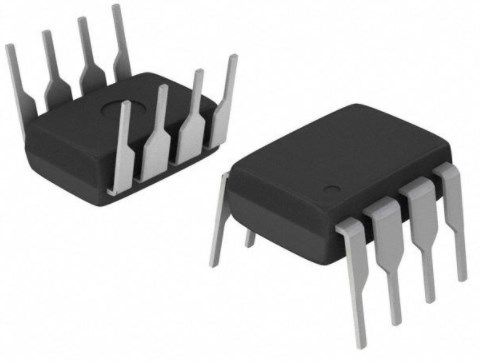 SN75176BP: Bus Transceiver, Pinout, Circuit
SN75176BP: Bus Transceiver, Pinout, Circuit28 March 20222051
 MIC5219 LDO Regulator: Datasheet, Pinout and Circuit
MIC5219 LDO Regulator: Datasheet, Pinout and Circuit04 August 20213819
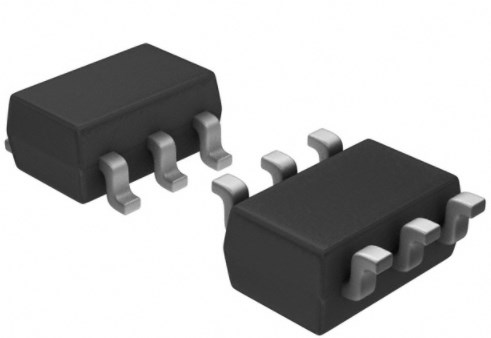 LM74700QDBVRQ1 Diode Controller: 12V, Pinout, Datasheet
LM74700QDBVRQ1 Diode Controller: 12V, Pinout, Datasheet07 March 20221944
 ST1S06PUR DC-DC converter: Pinout, Features and Datasheet
ST1S06PUR DC-DC converter: Pinout, Features and Datasheet14 August 2024420
 NCP18XH103F03RB NTC Thermistor 10k 0603: Datasheet, 3D Model, and Application
NCP18XH103F03RB NTC Thermistor 10k 0603: Datasheet, 3D Model, and Application21 February 20221004
 Overview of CH340 USB Converter Chip
Overview of CH340 USB Converter Chip12 October 202116101
 CSR8675 Premium Single-Chip : Datasheet, Features and Specifications
CSR8675 Premium Single-Chip : Datasheet, Features and Specifications28 July 20218288
 Arduino Nano ESP32: Overview, Features and Applications
Arduino Nano ESP32: Overview, Features and Applications06 October 20235767
 Comprehensive Guide to Xilinx SoC Boards and Tools
Comprehensive Guide to Xilinx SoC Boards and Tools04 June 2025278
 Core Components behind Smart Glasses
Core Components behind Smart Glasses28 June 20238713
 Semiconductor Market Predicted to Witness Significant Growth by 2023
Semiconductor Market Predicted to Witness Significant Growth by 202319 September 20231785
 Comparative Analysis of Si and SiC Devices for EV Traction Inverters
Comparative Analysis of Si and SiC Devices for EV Traction Inverters10 March 20233170
 In-depth Analysis of the Global Semiconductor Supply Chain
In-depth Analysis of the Global Semiconductor Supply Chain20 January 202211938
 Advancements and Challenges of High Frequency Converters
Advancements and Challenges of High Frequency Converters19 June 20231624
 Solenoid Switch: Working Principle, Types and Applications
Solenoid Switch: Working Principle, Types and Applications03 February 202124419
 How does the CPU Calculate 1+1?
How does the CPU Calculate 1+1?12 January 20223982
Vishay Semiconductor Opto Division
In Stock
United States
China
Canada
Japan
Russia
Germany
United Kingdom
Singapore
Italy
Hong Kong(China)
Taiwan(China)
France
Korea
Mexico
Netherlands
Malaysia
Austria
Spain
Switzerland
Poland
Thailand
Vietnam
India
United Arab Emirates
Afghanistan
Åland Islands
Albania
Algeria
American Samoa
Andorra
Angola
Anguilla
Antigua & Barbuda
Argentina
Armenia
Aruba
Australia
Azerbaijan
Bahamas
Bahrain
Bangladesh
Barbados
Belarus
Belgium
Belize
Benin
Bermuda
Bhutan
Bolivia
Bonaire, Sint Eustatius and Saba
Bosnia & Herzegovina
Botswana
Brazil
British Indian Ocean Territory
British Virgin Islands
Brunei
Bulgaria
Burkina Faso
Burundi
Cabo Verde
Cambodia
Cameroon
Cayman Islands
Central African Republic
Chad
Chile
Christmas Island
Cocos (Keeling) Islands
Colombia
Comoros
Congo
Congo (DRC)
Cook Islands
Costa Rica
Côte d’Ivoire
Croatia
Cuba
Curaçao
Cyprus
Czechia
Denmark
Djibouti
Dominica
Dominican Republic
Ecuador
Egypt
El Salvador
Equatorial Guinea
Eritrea
Estonia
Eswatini
Ethiopia
Falkland Islands
Faroe Islands
Fiji
Finland
French Guiana
French Polynesia
Gabon
Gambia
Georgia
Ghana
Gibraltar
Greece
Greenland
Grenada
Guadeloupe
Guam
Guatemala
Guernsey
Guinea
Guinea-Bissau
Guyana
Haiti
Honduras
Hungary
Iceland
Indonesia
Iran
Iraq
Ireland
Isle of Man
Israel
Jamaica
Jersey
Jordan
Kazakhstan
Kenya
Kiribati
Kosovo
Kuwait
Kyrgyzstan
Laos
Latvia
Lebanon
Lesotho
Liberia
Libya
Liechtenstein
Lithuania
Luxembourg
Macao(China)
Madagascar
Malawi
Maldives
Mali
Malta
Marshall Islands
Martinique
Mauritania
Mauritius
Mayotte
Micronesia
Moldova
Monaco
Mongolia
Montenegro
Montserrat
Morocco
Mozambique
Myanmar
Namibia
Nauru
Nepal
New Caledonia
New Zealand
Nicaragua
Niger
Nigeria
Niue
Norfolk Island
North Korea
North Macedonia
Northern Mariana Islands
Norway
Oman
Pakistan
Palau
Palestinian Authority
Panama
Papua New Guinea
Paraguay
Peru
Philippines
Pitcairn Islands
Portugal
Puerto Rico
Qatar
Réunion
Romania
Rwanda
Samoa
San Marino
São Tomé & Príncipe
Saudi Arabia
Senegal
Serbia
Seychelles
Sierra Leone
Sint Maarten
Slovakia
Slovenia
Solomon Islands
Somalia
South Africa
South Sudan
Sri Lanka
St Helena, Ascension, Tristan da Cunha
St. Barthélemy
St. Kitts & Nevis
St. Lucia
St. Martin
St. Pierre & Miquelon
St. Vincent & Grenadines
Sudan
Suriname
Svalbard & Jan Mayen
Sweden
Syria
Tajikistan
Tanzania
Timor-Leste
Togo
Tokelau
Tonga
Trinidad & Tobago
Tunisia
Turkey
Turkmenistan
Turks & Caicos Islands
Tuvalu
U.S. Outlying Islands
U.S. Virgin Islands
Uganda
Ukraine
Uruguay
Uzbekistan
Vanuatu
Vatican City
Venezuela
Wallis & Futuna
Yemen
Zambia
Zimbabwe










